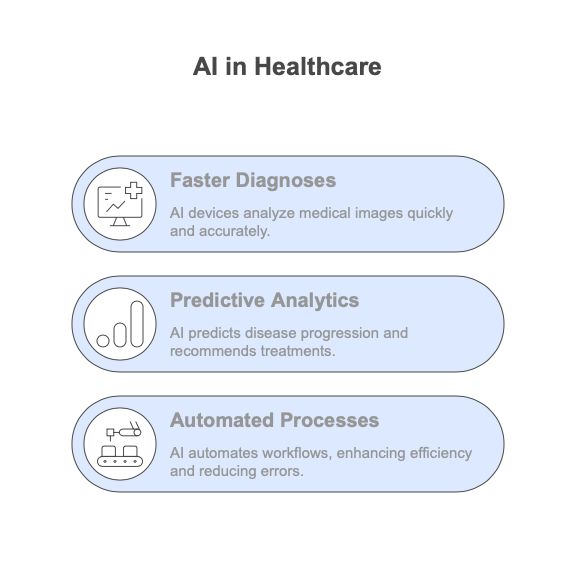The healthcare industry is experiencing a profound transformation, driven by medical device innovations that are reshaping patient care, enhancing diagnostic capabilities, and improving treatment outcomes. With the advent of cutting-edge technologies, medical devices are evolving into smarter, more connected, and highly efficient tools that are integral to modern healthcare systems.
From wearable health monitors to AI-powered diagnostic tools, the advancements in medical devices are changing how healthcare providers diagnose, treat, and monitor patients. These innovations not only improve clinical workflows but also offer patients more personalized and effective care. In this article, we will explore some of the most impactful medical device innovations that are transforming healthcare dynamics and the future potential of these technologies.
Table of Contents
The Role of Medical Device Innovations in Healthcare
Over the past few decades, technological advancements have significantly enhanced the functionality of medical devices, improving their accuracy, usability, and accessibility. Medical device innovations have made healthcare more efficient, safe, and effective, allowing for better patient outcomes and more personalized treatments.
The impact of medical device innovations can be seen across various areas of healthcare:
- Improved Diagnostics: Devices equipped with advanced sensors and imaging technologies are enabling more accurate and early diagnoses of conditions that were previously difficult to detect.
- Enhanced Monitoring: Remote patient monitoring and wearables allow healthcare providers to continuously track vital health parameters, reducing hospital visits and enabling proactive care.
- Minimally Invasive Treatments: New medical devices are making surgeries less invasive, reducing recovery time, and minimizing the risks associated with traditional surgical procedures.
- Personalized Care: The integration of data-driven insights and AI technologies is helping doctors tailor treatments to the unique needs of individual patients.
1. Wearable Health Devices: Monitoring Health on the Go
Wearable health devices, such as smartwatches, fitness trackers, and health-monitoring patches, are some of the most significant Medical Device Innovations in recent years. These devices empower individuals to monitor their health in real-time and provide healthcare providers with valuable data to improve patient outcomes.
Key Features of Wearables:
- Continuous Monitoring: Wearable devices can track various health metrics such as heart rate, oxygen saturation, sleep patterns, and physical activity. Some advanced wearables even track more specialized metrics, such as blood glucose levels or ECGs.
- Remote Health Monitoring: Many wearables are integrated with mobile apps and cloud-based platforms, allowing patients to share their data with healthcare providers remotely. This enables continuous monitoring of chronic conditions like diabetes, heart disease, and hypertension.
- Personalized Insights: By leveraging AI and machine learning, wearable devices can analyze data to provide personalized insights and recommendations, empowering patients to make informed decisions about their health.

Examples of Innovations:
- Apple Watch and Fitbit: Both offer features such as heart rate monitoring, ECG functionality, and fall detection, allowing users to track their health and alert healthcare providers in case of abnormalities.
- Continuous Glucose Monitors (CGMs): Devices like the Dexcom G6 and Freestyle Libre allow diabetic patients to monitor their glucose levels in real-time, reducing the need for frequent finger-pricking and helping to prevent dangerous fluctuations.
2. Artificial Intelligence in Diagnostics: Revolutionizing Detection
Artificial Intelligence (AI) and machine learning (ML) have become powerful tools in Medical Device Innovations, especially in diagnostic devices. AI algorithms can analyze vast amounts of medical data, such as medical images, genetic information, and patient records, to assist in diagnosing diseases, detecting abnormalities, and predicting patient outcomes.
Key Benefits of AI in Diagnostics:
- Faster and More Accurate Diagnoses: AI-powered devices can analyze medical images (e.g., X-rays, MRIs, CT scans) more accurately and quickly than human radiologists, reducing the chances of misdiagnosis.
- Predictive Analytics: AI can predict disease progression, identify at-risk patients, and recommend personalized treatment plans based on patient data.
- Automated Processes: AI enables automation in diagnostic workflows, reducing human error and increasing efficiency in healthcare settings.
Examples of Innovations:
- AI-Powered Imaging Systems: Companies like Zebra Medical Vision and Aidoc use AI algorithms to analyze radiology images for early detection of diseases such as cancer, heart disease, and neurological disorders.
- PathAI: This platform leverages AI to assist pathologists in analyzing tissue samples for more accurate cancer diagnosis, enhancing the ability to detect and treat cancer at early stages.
3. Minimally Invasive Surgical Tools: Precision with Less Risk
Minimally invasive surgery (MIS) has revolutionized the way many procedures are performed. Medical Device Innovations in this field, such as robotic-assisted surgery systems, endoscopes, and laser surgical tools, have made surgeries more precise, less traumatic, and quicker for patients.
Key Advantages of Minimally Invasive Surgical Tools:
- Reduced Recovery Time: Patients undergoing minimally invasive surgeries typically experience faster recovery, less pain, and fewer complications compared to traditional open surgeries.
- Smaller Incisions: MIS devices are designed to perform surgeries through smaller incisions, reducing the risk of infection and scarring.
- Enhanced Precision: Robotic surgical systems, like the da Vinci Surgical System, provide surgeons with enhanced dexterity, vision, and control, allowing them to perform complex procedures with greater precision.
Examples of Innovations:
- da Vinci Surgical System: This robotic system allows surgeons to perform delicate procedures with minimal incisions, offering better precision, smaller scars, and faster recovery times for patients.
- Endoscopic Surgery: Devices like flexible endoscopes and laparoscopes are used in a variety of procedures, such as colonoscopies and gallbladder removals, allowing for minimally invasive access to internal organs.
4. Point-of-Care Testing Devices: Bringing Diagnostics to the Patient
Point-of-care (POC) testing refers to diagnostic tests that can be performed at the patient’s location—whether at home, in a physician’s office, or in emergency settings—rather than in a centralized laboratory. Medical Device Innovations in POC testing are making it easier and faster for healthcare providers to diagnose a wide range of conditions.
Key Features of Point-of-Care Devices:
- Fast Results: POC devices deliver immediate test results, helping healthcare providers make faster decisions and start treatments quickly.
- Portability: Many POC devices are compact and easy to transport, making them ideal for use in remote areas, during emergencies, or for at-home patient testing.
- Diverse Applications: POC testing devices can be used for a wide range of tests, including glucose monitoring, infectious disease detection (e.g., COVID-19), and cardiac biomarkers.
Examples of Innovations:
- At-Home COVID-19 Testing Kits: These devices allow individuals to test for the coronavirus from the comfort of their homes, providing results within minutes.
- Abbott’s ID NOW: A portable molecular test for detecting infectious diseases, such as COVID-19 and influenza, in less than 15 minutes.
5. Robotic Exoskeletons: Enhancing Mobility and Rehabilitation
Recent Medical Device Innovations include medical robotic exoskeletons, which are wearable devices designed to assist individuals with mobility impairments. These devices are helping patients with spinal cord injuries, strokes, and other neurological conditions regain movement and independence.
Key Benefits of Robotic Exoskeletons:
- Restoring Mobility: Robotic exoskeletons help patients with paralysis or reduced mobility to stand, walk, and perform daily tasks, improving their quality of life.
- Rehabilitation: These devices are also used in rehabilitation programs to promote movement and muscle recovery in patients recovering from neurological damage.
- Improved Independence: Robotic exoskeletons allow patients to move independently, reducing their reliance on caregivers and enhancing their overall well-being.
Examples of Innovations:
- ReWalk: A wearable robotic exoskeleton that enables people with spinal cord injuries to stand, walk, and even climb stairs.
- EksoGT: A wearable exoskeleton used in rehabilitation for patients recovering from strokes, spinal cord injuries, and other neurological conditions.
6. Telemedicine and Remote Patient Monitoring: Transforming Healthcare Access
The rise of telemedicine and remote patient monitoring (RPM) has been one of the most significant innovations in healthcare. These technologies allow healthcare providers to remotely monitor patient health, conduct virtual consultations, and provide care to patients in underserved or rural areas.
Recent Medical Device Innovations include medical robotic exoskeletons, which are wearable devices designed to assist individuals with mobility impairments. These revolutionary Medical Device Innovations have transformed rehabilitation prospects for patients with limited mobility. Healthcare facilities investing in these Medical Device Innovations report significant improvements in patient outcomes and recovery timeframes.
The development trajectory of Medical Device Innovations in the exoskeleton field shows increasingly sophisticated motion detection and response mechanisms. As manufacturing processes improve, these Medical Device Innovations are becoming more affordable and accessible to a wider range of patients. Research centers focusing on Medical Device Innovations continue to refine exoskeleton designs with lighter materials and more intuitive controls. The next generation of Medical Device Innovations is expected to include brain-computer interfaces that allow direct neural control of exoskeleton movements.
Key Features of Telemedicine and RPM:
- Remote Consultations: Telemedicine allows doctors to consult with patients remotely, reducing the need for in-person visits and increasing access to healthcare services.
- Continuous Monitoring: RPM devices allow for continuous tracking of patients’ vital signs, such as heart rate, blood pressure, and glucose levels, from the comfort of their homes.
- Data Integration: The data collected from RPM devices can be integrated with electronic health records (EHRs), allowing healthcare providers to make informed decisions based on real-time data.
Examples of Innovations:
- Telehealth Platforms (e.g., Teladoc, Doctor on Demand): These platforms facilitate virtual consultations with healthcare providers, improving patient access to care, especially in rural or underserved areas.
- Health Monitoring Wearables: Devices such as the Omron HeartGuide and Fitbit allow patients to monitor their blood pressure and activity levels remotely, with data shared directly with healthcare providers.
Conclusion
Medical device innovations are transforming healthcare dynamics by improving patient care, enabling more accurate diagnostics, and increasing the accessibility of treatment options. From wearable health monitors to robotic exoskeletons, these innovations are making healthcare more efficient, personalized, and patient-centered. As these technologies continue to evolve, the future of healthcare looks more connected, data-driven, and inclusive than ever before.
The integration of AI, remote monitoring, and robotics in medical devices promises even more exciting possibilities in the near future, creating opportunities for developers, healthcare providers, and patients alike to benefit from groundbreaking advancements in medical technology.
What innovations in medical devices do you believe will have the greatest impact on healthcare in the next few years? How are you leveraging technology in your device development process?



 430 Park Ave, New York, NY 10022, USA
430 Park Ave, New York, NY 10022, USA Paevalille tn 6, Office 84, Estonia, Tallinn, 13517
Paevalille tn 6, Office 84, Estonia, Tallinn, 13517 Barykadna St 7, Dnipro, Ukraine, 49000
Barykadna St 7, Dnipro, Ukraine, 49000